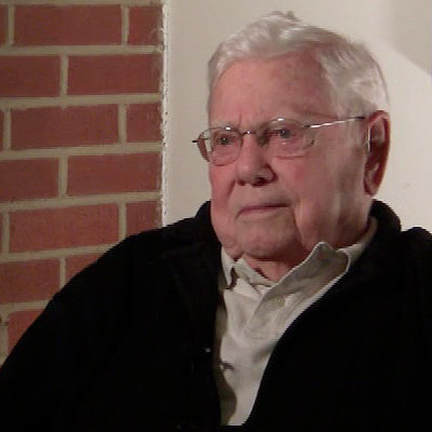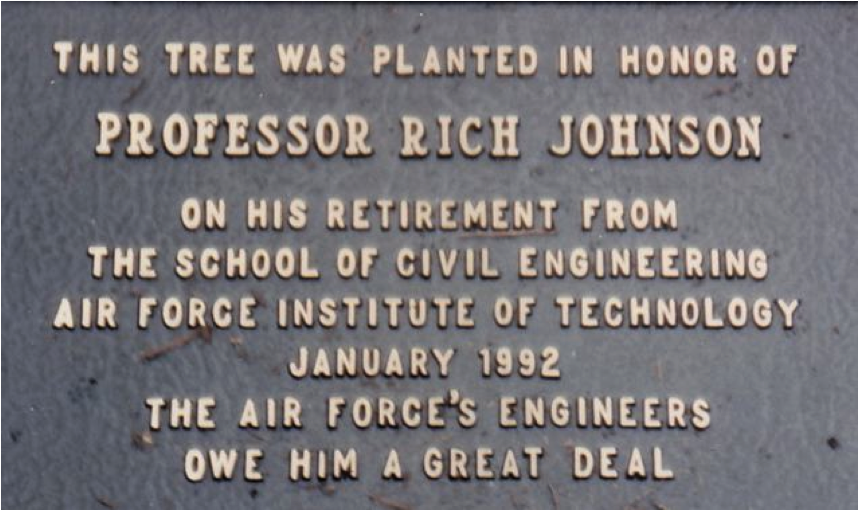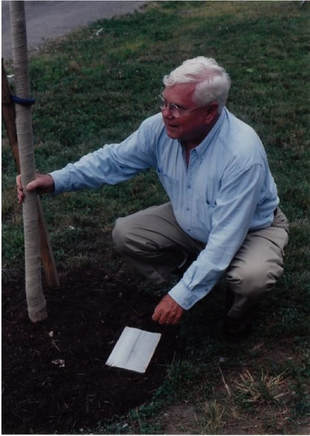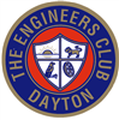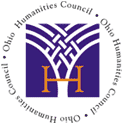Rich Johnson—Filling Far-Off Hearts and Minds
“The action has to be in the student!”
—Prof. Rich Johnson
|
Rich and Mary Ann Johnson have spent their careers taking information distanced by space and time and making it accessible to students and readers in the here and now. The Johnsons are long-time members of the Engineers Club of Dayton.
Rich Johnson discusses what it means to teach, the importance of involving students, and his thoughts on long-distance learning. Video Credits
J. Richardson Johnson—Filling Far-Off Hearts and Minds
By Mark Martel
Rich and Mary Ann Johnson have spent their careers taking information distanced by space and time and making it accessible to students and readers in the here and now. Rich helped pioneer distance learning across the media of print, telephone, TV and videotape. Mary Ann worked behind the scenes to research and promote the Dayton area’s unique aviation heritage that started with the Wright brothers’ invention of the airplane.
The Johnsons met at Miami University in Oxford, Ohio. Rich studied geology and Mary Ann sociology. They married during WWII at Cocoa, Florida where Rich served as a meteorologist at the Banana River Naval Air Station. As part of the Weather Service staff, he manned an isolated post on the east coast of Florida through several hurricanes, with only a jeep for retreat. Later in the Pacific Ocean he sailed aboard the USS PCE 886, a floating weather station at 10 degrees north, 130 degrees east, due east of the Philippines.
Postwar, Mary Ann ran their home while Rich worked for the Farm Bureau Insurance companies (today’s Nationwide Insurance) in Columbus, Ohio. There he discovered a knack for training others. “The day I started teaching, I stopped working.”
Often he’d drive off at the crack of dawn across state lines in a VW loaded with teaching material he’d helped develop. Over his career, Rich lectured at 20 universities, to all the US armed services and over 100 American industries. A favorite sculpture at home shows a weary but satisfied traveler.
Market efficiencies and new technologies created new possibilities for education. Distance learning dates to at least the early 1700s and grew alongside postal delivery. Charles Wedemeyer pioneered modern American distance learning in the 1930s, broadcasting lesson on the radio. By the 1960s the field grew as teaching spread to TV, audiotapes and videocassettes.
A simple early example caught Rich’s imagination. Across Australia’s thinly populated rural sheep ranches, bicycle-powered radios allowed children to interact with teachers hundreds of miles distant. Soon Johnson was doing considerably better. By mailing slides ahead, he could give illustrated talks over the phone, referring to a duplicate set of slides kept behind. It was like giving a PowerPoint talk remotely.
A “temporary” assignment in Dayton stretched out to 34 years at the Air Force Institute of Technology, or AFIT. There, Professor Johnson taught General Management courses, first in its Logistics School under a contract the Ohio State University had with the Air Force, and later in the Civil Engineering School as a civil service employee. With people to train around the globe, the Air Force sought more efficient means of teaching worldwide while minimizing travel. Rich became a prime mover in the field.
When the idea of videotaping lectures was first proposed many instructors balked, fearing their expertise would become unnecessary. Johnson was more confident and recorded numerous tapes. Anyone eligible could then request a tape, and when finished they simply mailed it back. Netflix has built their recent DVD business along similar lines.
Rich still managed to lecture elsewhere. He taught throughout US, Europe, Canada, the Near East and in the Pacific Rim, to audiences spanning the Chrysler Corporation to the Turkish General Staff. His many honors include being named a Fellow in the Society of American Military Engineers, and winning the Air Force’s Civil Engineering Minton Award for his writing. He rose to the professorial rank equivalent of Major General. Upon his 1992 retirement a Wright Brothers Maple tree (developed by Dayton’s Siebenthaler Company) was planted in his honor behind the Wright Cycle Company with a plaque noting, “The Air Force’s Engineers owe him a great deal.” He continued to speak, primarily on natural history and local history.
Distance learning continues to be practiced alone or with other teaching methods. The field has spread over time to computers and the Internet. Today 96% of large universities offer online courses.
More important than any temporary technology for delivering instruction, Johnson over his career made it a study to master the most effective means of teaching itself. As he notes in the video (above), the best results come from engaging students actively so they’re “coming at you.” Like a judo black belt, the best teachers turn the student’s energy upon itself; the student becomes their own teacher. Johnson says, “lectures fill notebooks, dialog fills minds and real-world experience under a good mentor fills hearts. Notebooks are nice; minds and hearts are essential.”
Thus Rich and Mary Ann Johnson have each found innovative ways to educate and influence people in the Miami Valley and around the world about history, engineering, science and technology. They made history themselves, celebrating their 65th wedding anniversary in 2009.
Rich and Mary Ann Johnson have spent their careers taking information distanced by space and time and making it accessible to students and readers in the here and now. Rich helped pioneer distance learning across the media of print, telephone, TV and videotape. Mary Ann worked behind the scenes to research and promote the Dayton area’s unique aviation heritage that started with the Wright brothers’ invention of the airplane.
The Johnsons met at Miami University in Oxford, Ohio. Rich studied geology and Mary Ann sociology. They married during WWII at Cocoa, Florida where Rich served as a meteorologist at the Banana River Naval Air Station. As part of the Weather Service staff, he manned an isolated post on the east coast of Florida through several hurricanes, with only a jeep for retreat. Later in the Pacific Ocean he sailed aboard the USS PCE 886, a floating weather station at 10 degrees north, 130 degrees east, due east of the Philippines.
Postwar, Mary Ann ran their home while Rich worked for the Farm Bureau Insurance companies (today’s Nationwide Insurance) in Columbus, Ohio. There he discovered a knack for training others. “The day I started teaching, I stopped working.”
Often he’d drive off at the crack of dawn across state lines in a VW loaded with teaching material he’d helped develop. Over his career, Rich lectured at 20 universities, to all the US armed services and over 100 American industries. A favorite sculpture at home shows a weary but satisfied traveler.
Market efficiencies and new technologies created new possibilities for education. Distance learning dates to at least the early 1700s and grew alongside postal delivery. Charles Wedemeyer pioneered modern American distance learning in the 1930s, broadcasting lesson on the radio. By the 1960s the field grew as teaching spread to TV, audiotapes and videocassettes.
A simple early example caught Rich’s imagination. Across Australia’s thinly populated rural sheep ranches, bicycle-powered radios allowed children to interact with teachers hundreds of miles distant. Soon Johnson was doing considerably better. By mailing slides ahead, he could give illustrated talks over the phone, referring to a duplicate set of slides kept behind. It was like giving a PowerPoint talk remotely.
A “temporary” assignment in Dayton stretched out to 34 years at the Air Force Institute of Technology, or AFIT. There, Professor Johnson taught General Management courses, first in its Logistics School under a contract the Ohio State University had with the Air Force, and later in the Civil Engineering School as a civil service employee. With people to train around the globe, the Air Force sought more efficient means of teaching worldwide while minimizing travel. Rich became a prime mover in the field.
When the idea of videotaping lectures was first proposed many instructors balked, fearing their expertise would become unnecessary. Johnson was more confident and recorded numerous tapes. Anyone eligible could then request a tape, and when finished they simply mailed it back. Netflix has built their recent DVD business along similar lines.
Rich still managed to lecture elsewhere. He taught throughout US, Europe, Canada, the Near East and in the Pacific Rim, to audiences spanning the Chrysler Corporation to the Turkish General Staff. His many honors include being named a Fellow in the Society of American Military Engineers, and winning the Air Force’s Civil Engineering Minton Award for his writing. He rose to the professorial rank equivalent of Major General. Upon his 1992 retirement a Wright Brothers Maple tree (developed by Dayton’s Siebenthaler Company) was planted in his honor behind the Wright Cycle Company with a plaque noting, “The Air Force’s Engineers owe him a great deal.” He continued to speak, primarily on natural history and local history.
Distance learning continues to be practiced alone or with other teaching methods. The field has spread over time to computers and the Internet. Today 96% of large universities offer online courses.
More important than any temporary technology for delivering instruction, Johnson over his career made it a study to master the most effective means of teaching itself. As he notes in the video (above), the best results come from engaging students actively so they’re “coming at you.” Like a judo black belt, the best teachers turn the student’s energy upon itself; the student becomes their own teacher. Johnson says, “lectures fill notebooks, dialog fills minds and real-world experience under a good mentor fills hearts. Notebooks are nice; minds and hearts are essential.”
Thus Rich and Mary Ann Johnson have each found innovative ways to educate and influence people in the Miami Valley and around the world about history, engineering, science and technology. They made history themselves, celebrating their 65th wedding anniversary in 2009.
Related to Rich Johnson and Distance Learning
Valley of the Giants -
J. Richardson Johnson
Rich Johnson 2009 Oral History Transcript (PDF)
“Six Pack” - a lecture by Rich Johnson (PDF) Rich describes six types of people in workforce and management, and how they get along.
Air Force Institute of Technology (AFIT)
Mr. Alf Traeger transmitting by a pedal-powered wireless.
The Pedal Radio of the Great Outback. By Richard Begbie. Antique Radio Classified
Traeger Pedal Radio
J. Richardson Johnson
Rich Johnson 2009 Oral History Transcript (PDF)
“Six Pack” - a lecture by Rich Johnson (PDF) Rich describes six types of people in workforce and management, and how they get along.
Air Force Institute of Technology (AFIT)
Mr. Alf Traeger transmitting by a pedal-powered wireless.
The Pedal Radio of the Great Outback. By Richard Begbie. Antique Radio Classified
Traeger Pedal Radio
Dayton Innovation Legacy is a multimedia website and educational resource about Engineers Club of Dayton members who represent a living history of innovation for over 100 years. Dayton Innovation Legacy was made possible in part by the Ohio Humanities Council, a State affiliate of the National Endowment for the Humanities. |

